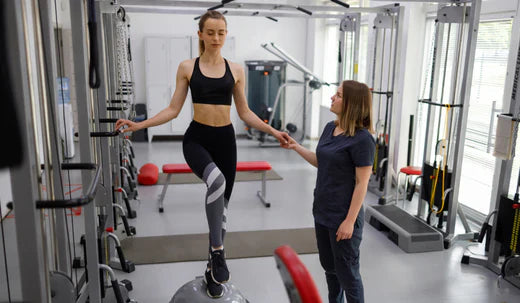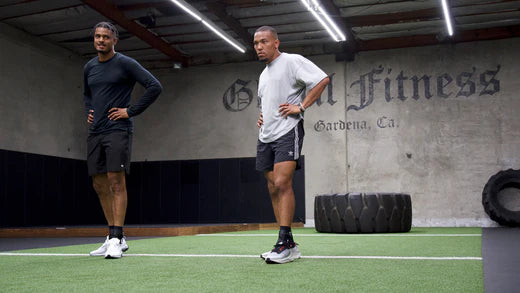The ankle is one of the most important structures in our body because it helps us to carry our body weight and move around. However, the ankle is also vulnerable to injury. That's why it's important to stabilize and strengthen it to prevent injuries or to get back into training quickly after an injury.
Why you should stabilize your ankle
After a torn ligament, there is a significantly increased risk of suffering another ankle injury. The main reasons for this are permanent instability and muscular deficits. In addition, athletes often return to training too early without fully recovering from their ankle injury. That's why you should stabilize your ankle. We want to show you exercises that will reduce discomfort and get you back on the pitch as quickly as possible. However, since every body and every rehabilitation phase is different, you should discuss with your doctor or physiotherapist which exercises are best for you at which point in time.

Stabilizing your ankle: exercises to help you
These four exercises can help you to stabilize and strengthen your ankle, prevent pain and sprains.
Ankle exercise 1: Balance exercise
Stand on one leg, holding the other in the air. Hold this position for 30 seconds. Then switch sides. Advanced users can also do the exercise with their eyes closed or on unstable ground, such as a soft mat or a folded towel. If you play ball sports, you can of course also dribble a basketball or pass a ball with a partner while doing the exercise.

Exercise 1: Balancing on one leg (2 variations)
Ankle exercise 2: One-legged landing
In addition to static one-legged standing, you can also train dynamic falling. To do this, stand on one leg and make a small, targeted jump forward or to the side, landing back on the same leg. Try to cushion the landing as well as possible and quickly regain your balance.

Exercise 2.1: Standing on one leg, jumping to the side

Exercise 2.2: Standing on one leg, jumping forward
Ankle exercise 3: Strengthening
Strengthening the ankle and foot muscles also helps with active stabilization. To do this exercise, stand with the balls of your feet on a step and slowly push yourself up onto your toes. Hold the position for a few seconds and then slowly lower your heels again so that they are lower than the step. Repeat the exercise 10 times. Advanced users can also do the exercise on one leg.

Exercise 3: Raising and lowering your heels standing on a step
Ankle joint exercise 4: Mobilization
To improve the mobility of the ankle joint, you can do the following exercises. It is best to sit on a chair and keep your foot free in the air. Now slowly make as large a circle as possible with your foot. Repeat the movement 10 times to the left and 10 times to the right. Then do the ankle exercise with the other foot. As well as circling your foot, you can also bend and stretch it as much as possible. Follow the same exercise routine. It's best to do these exercises separately from your other training, as these ankle exercises can cause the muscles to become very tired.

Exercise 4.1: Drawing a circle with your foot

Exercise 4.2: Stretching and pulling your feet towards the body
What else you can do to prevent ankle injuries

In addition to exercises to improve balance and strengthen the muscles, there are other measures that can help you prevent ankle injuries:
Wear suitable shoes
You should always wear shoes that fit and are suitable for your needs. They should fit well to give you the stability you need when changing direction and starting. You should also change your shoes regularly, as the sole can lose its cushioning and grip over time.
Warm-up:
Before every training session and competition, you should warm up sufficiently to prepare your muscles and joints for the intense physical strain. This could be jogging, running drills or stretching the muscles, for example.
Stabilization aids such as bandages, orthoses or tape
Another way to stabilize your ankle is to use aids such as orthoses, bandages or tape. These are popular in many sports. But be careful: although these externally applied products passively stabilize your ankle from the outside, regular use of them can reduce the body's own stabilization through the muscles.
The innovative ankle brace from Betterguards provides a remedy here: it works like a seat belt in a car and offers you full freedom of movement. However, as soon as a critical movement occurs, the brace intervenes and stabilizes your ankle. During normal sporting activities, your muscles and sense of balance continue to be trained. Check out The BetterGuard now!






